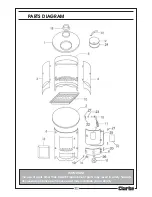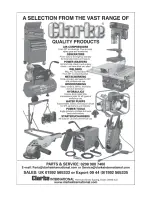
15
WARNING: THE TEMPERATURE REACHED BY THESE ITEMS DURING
OPERATION MAY CAUSE AN INJURY TO AN END-USER. AS THESE ARE
INTENDED TO BE ADJUSTED DURING OPERATION, IT IS RECOMMENDED
THAT PROTECTIVE GLOVES ARE WORN WHEN HANDLING THESE PARTS.
TYPES OF FUEL
A mixture of fuels can be used in conjunction with wood, provided the base
of the fire remains as wood or compressed block fuels. Coal products can be
added to this, provided the volume of coal products is less than that of other
fuels.
With solid fuels, there is less need to burn the stove hard after refuelling. The
rate of refuelling will also be less often than with wood.
This stove will function with wood or coal, but in general all fuel should be dry
and timber should be well seasoned so as to have a moisture content below
20%. The use of damp wood will result in more soot and tar deposits being left
in the chimney, flue and stove, and will not release heat if thermal energy is
being used to drive out moisture from the fuel.
Other fuels can be used in conjunction with wood, provided the base of the
fire remains as wood or compressed block fuels. Coal products can be
added to this provided the volume of coal products is less than that of other
fuels.
With solid fuels, there is less need to burn the stove hard after refuelling. The
rate of refuelling will also be less often than with wood.
Avoid using the stove to incinerate other materials including household
waste.
Avoid using ‘green’ unseasoned wood, treated wood such as telegraph
poles, or plywood / chipboard containing glues and resins which pollute the
environment and cause the fire to burn too quickly. Such materials can
produce excessive tar or creosote which can be damaging and in extreme
cases cause a fire inside the chimney.
The dryness of wood can be assessed by looking at the end of the log. Radial
cracks, deep enough to be considered as splits should be present in dry,
seasoned logs. This level of dryness may take up to two years to achieve.
The maximum length of fuel suitable for this stove is approx 30 cm so as to lay
flat over the embers, and logs of greater than 10 cm diameter should be split.
Confirm with your fuel provider as to which type will suit best. Larger fuels will
allow a greater draught in the firebox which will speed up combustion.
Household coal produces more ash & chimney deposits than smokeless fuels.
For further information on type and availability of fuel, the Solid Fuel
Association (http:/www.solidfuel.co.uk) serves as an advice centre to
domestic consumers including all aspects of fuel types.
Summary of Contents for BARREL
Page 1: ...USER GUIDE GC0711 Classic Cast Iron Stove BARREL PART NO 6910100 ...
Page 23: ...23 DECLARATION OF CONFORMITY ...
Page 24: ......










































